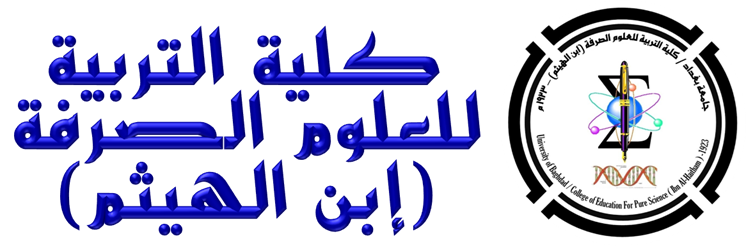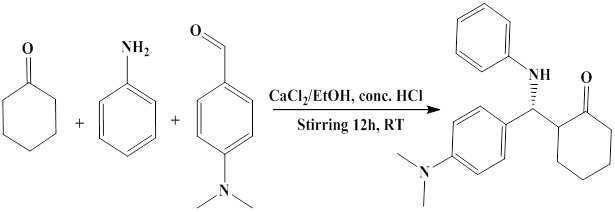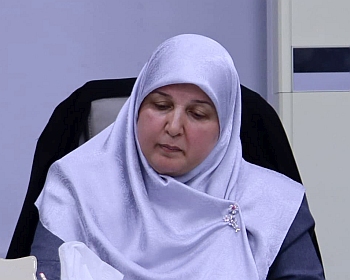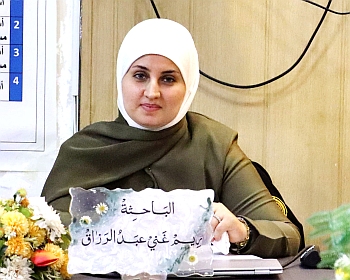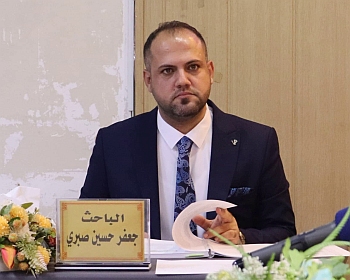ناقش قسم الكيمياء في كلية التربية للعلوم الصرفة (ابن الهيثم) رسالة الماجستير الموسومة (تحضير وتشخيص طيفي لمعقدات فلزية للكندات متعددة المخلب) في تخصص (الكيمياء العضوية ) للطالب ( صفاء الدين علي حسين) التي انجزت باشراف التدريسي في القسم (أ. د. محمد جابر ابراهيم) وتمت مناقشتها على قاعة المرحوم (أ.د. فهد علي حسين) من قبل اعضاء لجنة المناقشة :
-
أ.د. حسن احمد حسن (رئيساً)
-
أ.م.د. اسامة احمد سامح (عضواً)
-
أ.م.د. رياض محمود احمد (عضواً)
-
أ.د. محمد جابر ابراهيم (عضواً ومشرفاً)
وتهدف الرسالة الى :
1- تحضير لكندات ثنائية المخلب جديدة تعتمد على قواعد مانخ مشتقة من ثلاث مواد اولية هي: الهكسانون الحلقي و الانلين و 4-ثنائي امين بنزالدهايد.
2- تحضير لكندات ثلاثية المخلب جديدة لمركبات السمي كاربازون تعتمد على قواعد شيف ومشتقة من مركبات مانخ المحضرة في المرحلة الاولى.
3- تحضير معقدات فلزية لكلا اللكندين مع مختلف العناصر الانتقالية.
4- دراسة الكيمياء الفراغية لكلا اللكندين مع مختلف معقداتها الفلزية.
5- دراسة الفعالية البايولوجية لمختلف المركبات المحضرة مع اربعة انواع من البكتريا المرضية ذات الانتشار الواسع في غرف العمليات الجراحية والمتسببة في العديد من الامراض الخطيرة, وكذلك نوعين من الفطريات المرضية ذات التأثير الواسع على حياة الانسان والحيوان والنبات.
تضمن هذا العمل تحضير نوعين من الليكندات مع معقداتها الفلزية. اللكند الاول يسمى :
(R)-2-((R)-(4-(dimethylamino)phenyl)-(phenyl-amino)methyl)cyclohexan -1-one (HL1)
تم تحضيره وفقا لتفاعل مانخ باستخدام كلوريد الكالسيوم كعامل مساعد. التفاعل تم باستخدام الكحول الاثيلي كوسط للتفاعل ومن خلال مزج ثلاث مكونات هي : 4-ثنائي-مثيل-امينو بنزلديهايد , الانلين و السايكلوهكسانون بنسبة مولية مقدارها 3:3:5, على التوالي ثم تم تحريك المزيج طوال الليل وبدرجة حرارة الغرفة. المادة الصلبة التي تكونت تم ترشيحها ثم غسلها بواسطة الماء والكحول والايثر. اللكند الثاني واسمه :
(E)-2-((S)-2-((S)-(4-(dimethylamino)-phenyl)-(phenyl-amino)methyl)-cyclohexylidene)hydrazine-1-carboxamide (H2L2)
تم تحضيره من تفاعل اللكند الاول مع مادة سمي كاربازايد هيدروكلورايد. التفاعل تم بمزج محلول مثيلي لكل من اللكند الاول والسمي كاربازايد هيدروكلورايد بنسبة مولية مقدارها 1:1. التفاعل تم باستخدام التصعيد العكسي لمدة 6 ساعات. بعد ذلك تم غسل المركب الناتج بواسطة الكحول الاثيلي والايثر.
المخطط (أ) : الطريقة العامة لتحضيراللكند الاول HL1.
 المخطط (ب) : الطريقة العامة لتحضير اللكند الثاني H2L2.
المخطط (ب) : الطريقة العامة لتحضير اللكند الثاني H2L2.
كلا اللكندين تم استخدامهما لتحضير سلسلة من المعقدات الفلزية مع ايونات :
Mn(II), Co(II), Ni(II), Cu(II), Zn(II) and Cd(II)
وذلك بمزج نسبة مولية مقدارها 2:1 (فلز:لكند) باستخدام الايثانول او dmf كوسط للتفاعل. تم تحريك المزيج طوال الليل وبدرجة حرارة الغرفة , تم بعدها عزل المركبات الملونة . اللكند الاول HL1انتج معقدات فلزية مونمرية صيغتها العامة :
[M(HL1)2(Cl)2](H2O)2 (where M= Mn(II), Co(II), Ni(II), Cu(II) and [M(HL1)](H2O)2Cl2 (where M= Zn(II) and Cd(II))
بينما انتج الكند الثاني H2L2 معقدات بوليمرية وحدتها البنائية ذات صيغة :
[M(HL1)2(Cl)2]n (where M= Mn(II), Co(II), Ni(II), Cu(II), Cd(II) and {[M(HL1)]Cl2}n (where M= Co(II), Ni(II) and Cd(II))
تم تشخسص اللكندات ومعقداتها الفلزية باستخدام طرائق فيز-كيميائية مثل التحليل الدقيق للعناصر, محتوى المعدن والكلور, مطياف الاشعة تحت الحمراء, ومطياف الاشعة فوق البنفسجية , والرنين النووي المغناطيسي (1H,13C) ومطيافية الكتلة بالاضافة الى فحص الحساسية المغناطيسية , التوصيلية المولارية و ودرجة الانصهار.
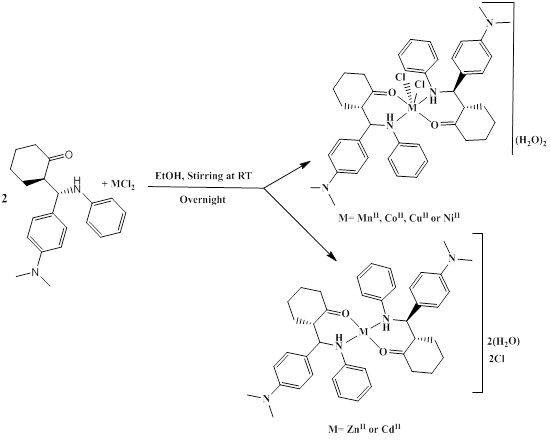 المخطط (ج) : الطريقة العامة لتحضي معفدات اللكند الاول HL1.
المخطط (ج) : الطريقة العامة لتحضي معفدات اللكند الاول HL1.
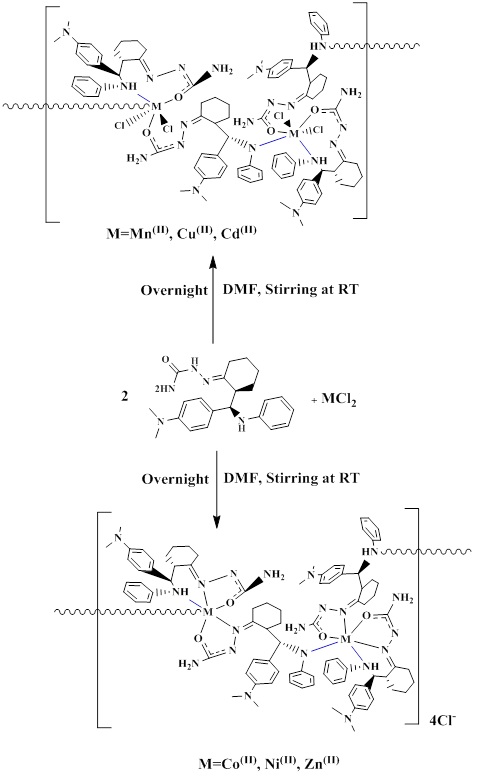 المخطط (د) : الطريقة العامة لتحضير معقدات اللكند الثاني H2L2.
المخطط (د) : الطريقة العامة لتحضير معقدات اللكند الثاني H2L2.
واعتمادا على المعطيات التحليلية والطيفية تم اقتراح الاشكال الاتية:
1- اشكال ثمانية السطوح مشوهه بالنسبة لمعقدات الكند الاول مع ايونات Mn(ӀӀ), Co(ӀӀ), Ni(ӀӀ) and Cu(ӀӀ).
2- اشكال رباعية السطوح بالنسبة لمعقدي اللكند الاول مع ايونات Zn(II) Cd(II).
3- اشكال ثمانية السطوح مشوهه بالنسبة لمعقدات اللكند الثاني مع جميع الايونات.
تم تشخيص الفعالية البايولوجية لكلا اللكندين مع معقداتها الفلزية بالنسبة لنوعين من البكتريا : موجبة لصبغة غرام: (Staphylococcus aureus)
وسالبة لصبغة غرام:
(Escherichia coli, Pseudomonas aeruginosa and Listeria monocytogenes)
والتي تعتبر من اكثرانواع البكتريا المرضية فتكا, واكثرها انتشارا في صالات العمليات الجراحية .
في هذا العمل تم تشخيص الفعالية اتجاه نوعين من الفطريات وهي Dermatophytes و Fuzarum والتي تعتبر من الانواع التي تهاجم النبات والحيوان والانسان.
وخلصت الرسالة الى التوصيات التالي :
-
تحضير لكندات مانخ جديدة وبمعوضات مختلفة.
-
تحضير لكندات سمي كاربازون جديدة وبمعوضات مختلفة.
-
تحضير معقدات مع السلسلة الانتقالية الثانية و الثالثة.
-
دراسة الفعالية البايولوجية ضد اطياف اخرى من البكتريا والفطريات المرضية.
-
دراسة قابلية مضادات السرطان لمختلف المركبات المحضرة.
Thesis address : Formation and spectral characterization
of metal complexes with multidentate ligand
Study field : Chemistry Science/Inorganic Chemistry
Researcher : Safaudeen A Hussain
Supervisor : Prof. Dr. Mohamad J Al-Jeboori/ Head of Department of Chemistry, College of Education for Pure Science /(Ibn-Al-Haitham ) University of Baghdad, Iraq
Aim of the work
The aims of this work including the synthesis, structural characterisation and microbiological activity of two kind ligands bearing N and O atoms and their metal complexes. This contains:
-
Synthesis of new bidentate Mannich-base ligand namely; (R)-2-((R)-(4-(dimethylamino)phenyl)(phenyl-amino)methyl)cyclohexan-1-one (HL1) from three organic component (cyclohexanone, aniline, 4-dimethylaminobenzaldehyde). This ligand, also used to synthetic another ligand (H2L2) based on Schiff-base.
-
synthesis of new tridentate Schiff-base ligand namely; (E)-2-((S)-2-((S)-(4-(dimethylamino)-phenyl)-(phenyl-amino)methyl)cyclo- hexylidene)hydrazine-1-carbox- amide (H2L2) by reacting HL1 with semicarbazidehydrochloride.
-
Formation a metal complexes from both ligands with several kind of transitions metals.
-
Studying the stereochemistry of prepared complexes and their possible structures.
-
Studying the microbiological activity of the ligands and their complexes against G+ and G- strains of bacteria and two type of fungi.
Prospective studies
-
Preparation of new Mannich-base ligands with different substituents.
-
Preparation of new semicarbazone ligands with different substituents.
-
Preparation of new metal complexes with the above ligand that based on the second and/or third series of transition ions.
-
Working on the recrystallisation of the ligands and their metal complexes to isolate compound suitable for X-ray single crystal.
-
Expanding the microbiological activity study by testing the ligands and their metal complexes against other microorganisms.
-
Studying the anti-cancer activity and DNA cleavage of the prepared compounds.
Summary
This work based on the synthesis and spectral characterisation of two types of ligands and their metal complexes. The formation of first ligand (R)-2-((R)-(4-(dimethylamino)phenyl)-(phenyl-amino)methyl) cyclohexan-1-one (HL1) was based on Mannich reaction using CaCl2 as a catalyst. The reaction was performed in EtOH by mixing three components; 4-dimethylaminobenzaldehyde, aniline and cyclohexanone with a 3:3:5 mole ratio. The mixture was stirred overnight at RT, then the solid product that formed filtered off and washed with water, EtOH and ether, see Scheme(I). The second ligand (E)-2-((S)-2-((S)-(4-(dimethylamino)-phenyl)-(phenyl-amino)methyl)-cyclohexylidene)-hydrazine-1-carboxamide(H2L2) was prepared from the reaction of HL1 with semicarbazide hydrochloride moiety. The reaction was achieved by mixing a methanolic solution of semicarbazide hydrochloride and HL1 in a 1:1 mole ratio. The reaction was allowed to reflux for 6 h and the solid product was filtered off and washed with ethanol and ether, Scheme (I).
Scheme (I): General synthetic route of HL1 and H2L2.
The HL1 and H2L2 were used to synthesis a series of complexes with Mn(II), Co(II), Ni(II), Cu(II), Zn(II) and Cd(II) ions in a 1:2 (M:L) mole ratio using ethanol or DMF as a solvent. The reaction mixture was allowed to stir overnight and colour solids were isolated. The HL1 gave monomeric complexes with the title metal ion of the general formula [M(HL1)2(Cl)2](H2O)2 (where M= Mn(II), Co(II), Ni(II), Cu(II) and [M(HL1)](H2O)2Cl2 (where M= Zn(II) and Cd(II)), see Scheme (II). The H2L2 gave polymeric complexes upon reaction with the title metal ion of the general formula {[M(HL2)2(Cl)2]}n (where M= Mn(II), Cu(II), Cd(II) and {[M(HL2)]Cl2}n (where M= Co(II), Ni(II) and Zn(II)), see Scheme (III).
The entity of ligands and their metal complexes were confirmed using a range of physico-chemical analysis including; micro-analysis, metal and chloride ratio. Further, spectroscopic methods include; FT-IR, U.V-Vis, 1H and 13C NMR, electrospray (+) mass spectroscopy, along with magnetic susceptibility, molar conductivity and melting point.
Scheme (II): General synthetic route of HL1 complexes.
Scheme (III): General synthetic route of H2L2 complexes.
Based on the analytical and spectroscopic data, the following structures are suggested;
-
Distorted octahedral geometries for HL1 complexes with Mn(ӀӀ), Co(ӀӀ), Ni(ӀӀ) and Cu(ӀӀ)
-
The Zn(II) Cd(II) complexes adopt tetrahedral arrangement.
-
Distorted octahedral geometries about metal centre with H2L2 complexes with Mn(ӀӀ), Co(ӀӀ), Ni(ӀӀ), Cu(ӀӀ), Zn(II) and Cd(II)
